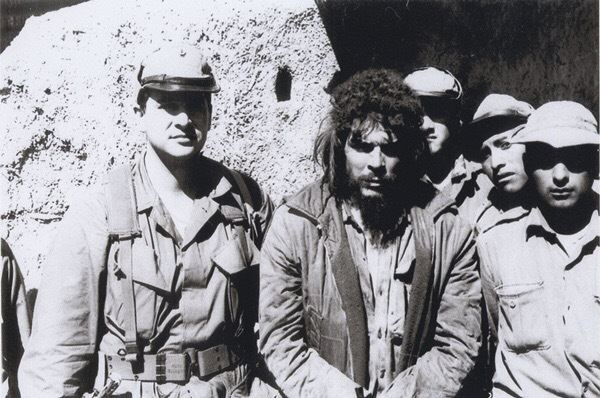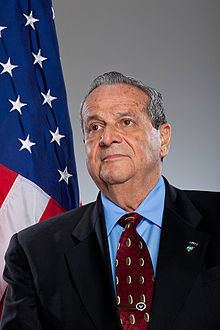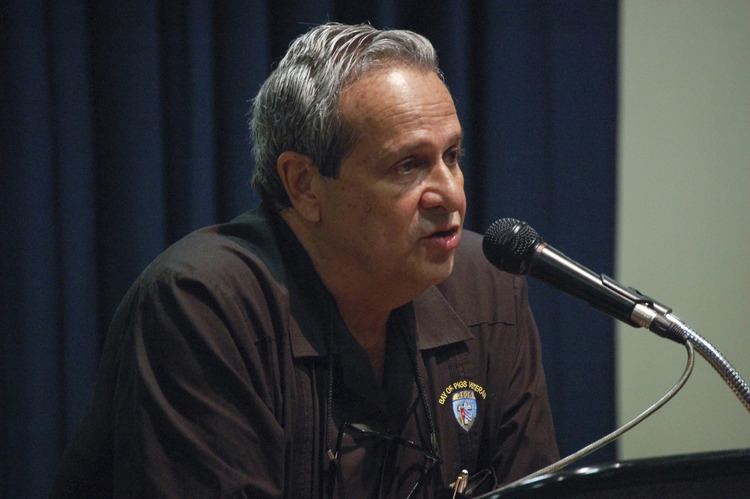Allegiance United States Rank Colonel | Years of service 1959 – Present | |
 | ||
Nickname(s) Lázaro, Max Gómez, Félix Ramos Medina, Félix El Gato Battles/wars Bay of Pigs InvasionOperation MongooseLaotian Civil WarÑancahuazú GuerrillaVietnam War1973 coup in ChileContra War Other name Lázaro, Max Gómez, Félix Ramos Medina, Félix El Gato Units Special Activities Division, Special Forces Similar Mario Terán, Luis Posada Carriles, Aleida March, Orlando Bosch, Kiki Camarena | ||
Félix Ismael Rodríguez Mendigutia (born 31 May 1941) is a former Central Intelligence Agency officer, known for his involvement in the Bay of Pigs Invasion, in the execution of Leftist revolutionary Che Guevara and his ties to George H. W. Bush during the Iran–Contra affair. He is Cuban American.
Contents

Biography

His uncle was minister of Public Works during the Fulgencio Batista dictatorship in Cuba. His family was fairly wealthy and owned land. After the Cuban Revolution several of his family members were captured by the Communist Forces and executed.

He attended the Perkiomen School in Pennsylvania, but dropped out to join the Caribbean Anti-communist Legion, created by Dominican dictator Rafael Trujillo, with the intention of ending communism in Cuba.

The invasion of Cuba was a failure and Rodríguez went back to Perkiomen. He graduated in June 1960, and went to live with his parents in Miami, where thousands of Cuban exiles had moved.
In September, 1960 he joined a group of Cuban exiles in Guatemala, supported by the Central Intelligence Agency (CIA), to receive military training. They were called Brigade 2506.
Bay of Pigs Invasion
He was a Paramilitary Operations Officer from Special Activities Division. He joined and became a leader in the CIA-backed Operation 40 and Brigade 2506, and illegally entered Cuba a few weeks before the failed Bay of Pigs Invasion. Utilizing his familiarity with the country, he was able to gather critical intelligence to be used in the planning and preparation for the invasion.
His colleagues in Operation 40 included David Atlee Phillips, David Morales, Ted Shackley, E. Howard Hunt, Frank Sturgis, and Porter Goss among others.
Bolivia
In 1967, the CIA recruited Rodríguez to train and head a team to hunt down Marxist guerrilla fighter Che Guevara, who was attempting to overthrow the US-backed government in Bolivia.
He claims that he and Guevara spoke civilly regarding the failing economy of Cuba and Guevara's tactics in starting a revolution in Bolivia. Rodríguez stated that he wanted to keep Guevara alive for further interrogation, but was thwarted by the order of the Bolivian president that Guevara be summarily executed. Rodríguez, whose cover was that of a Bolivian army major, repeated those orders, later stating that it was a Bolivian decision, and Guevara was killed. Rodríguez has in his possession Guevara's Rolex wristwatch.
The last photograph of Guevara alive includes Rodriguez standing by his side.
Vietnam
He became a U.S. citizen in 1969, soon enlisting in the United States Army. During his career with the CIA he also went by the name Máximo Gómez. He was awarded the Intelligence Star for Valor by the CIA and nine Crosses for Gallantry by the South Vietnamese government. He was codenamed Lazarus after his survival of the Bay of Pigs invasion operation.
In the Vietnam War, Rodríguez flew over 300 helicopter missions, and was shot down five times. In 1971, Rodríguez trained Provincial Reconnaissance Units (PRUs). PRUs were CIA-sponsored units that worked for the Phoenix Program. The Walsh Report states (Chapter 29): "During the Vietnam War, [Donald] Gregg supervised CIA officer Felix Rodriguez and they kept in contact following the war." Rodríguez also reported to Ted Shackley during the Phoenix Program - Shackley became Bush's top aide for operations when he directed the CIA; Gregg later became National Security Advisor for Vice President Bush. Rodríguez was in frequent contact with him regarding arms for the Contras.
In 1970 after the Cambodian Incursion, Bien Hoa CIA Spymaster Orrin DeForrest worked with Rodriguez (whom he described as "the CIA's hotshot pilot") and his PRU in rolling up the Viet Cong stronghold of An Tinh in South Vietnam. Rodriguez flew above the village in a Loach light helicopter and marked target houses holding VC suspects with orange smoke, after which the PRU went in and emptied the houses of occupants, lined them up, whereupon they identified suspects with the assistance of a former VC leader who had been previously captured and was now cooperating with the CIA whom DeForrest identified as "Ba Tung." The operation netted twenty-eight VC cadre who had been living openly among the South Vietnamese people but working to assist the North Vietnamese overthrow their southern neighbors. The mass arrest and detention of Subregion One VC cadre was the largest operation of its type during the war and for all intents and purposes broke the VC hold on their stronghold of An Tinh.
Iran-Contra and ties to George H.W. Bush
There is extensive documentation of Rodriguez' ties to US vice-president George H. W. Bush during the Iran–Contra affair, from 1983–88. In September 1986 General John K. Singlaub wrote Oliver North expressing concern about Félix Rodríguez's daily contact with the Bush office and warned of damage to President Ronald Reagan and the US Republican Party. The Walsh Report (Chapter 25) states that M. Charles Hill took notes at a meeting between George Shultz and Elliott Abrams on 16 October 1986, as follows:
Felix Rodriguez [sic] – Bush did know him from CIA days. FR [Rodriguez] is ex-CIA. In El Salv[ador] he goes around to bars saying he is buddy of Bush. A y[ea]r ago Pdx [Poindexter] & Ollie [North] told VP staff stop protecting FR as a friend – we want to get rid of him from his involvnt [sic] w[ith] private ops. Nothing was done so he still is there shooting his mouth off. (brackets are in the original)
Rodríguez met with Donald Gregg, who by then was Bush's National Security advisor. The Walsh Report (Chapter 29) states: "Gregg introduced Rodriguez to Vice President Bush in January 1985, and Rodriguez met with the Vice President again in Washington, D.C., in May 1986. He also met Vice President Bush briefly in Miami on May 20, 1986."
Rodríguez also met and spoke repeatedly with Bush's advisor Gregg and his deputy (Col. Samuel J. Watson III). As one indicator of this connection, a single chapter in the Walsh Report titled "Donald P. Gregg" (Chapter 29) contains 329 references to Rodríguez.
On 5 October 1986, the Corporate Air Services C-123 carrying Eugene Hasenfus was shot down over Nicaragua, killing two US pilots, William H. Cooper and Wallace B. Sawyer, Jr., and one Latin American crew member. "Rodriguez unsuccessfully attempted to call Gregg to inform him of the missing plane. He reached Watson, who in turn notified the White House Situation Room. The following day, Rodriguez called Watson again and told him that the airplane was one of North's." Hasenfus told reporters that he worked for "Max Gomez" (an alias for Felix Rodriguez) and "Ramon Medina" (an alias for Luis Posada Carriles) of the CIA. On 10 October 1986, Clair George, head of CIA clandestine operations, testified before Congress that he did not know of any direct connection between Hasenfus and Reagan administration officials. In Fall of 1992, George was convicted on two charges of false statements and perjury before Congress; he was pardoned Christmas Eve that year by then-President Bush.
Activism
In 2004 Rodríguez became President of the Brigade 2506 Veterans Association, a group for Bay of Pigs Invasion survivors.
During the 2004 US Presidential election, Rodríguez was highly critical of Democratic candidate John Kerry, due in part to their previous meeting at a Senate Subcommittee on Terrorism and Narcotics hearing in 1987. During one session Kerry accused him of soliciting a $10 million donation from the Colombian cocaine cartel. The story had originally come from Ramón Milian Rodríguez, a convicted money launderer from Colombia. Rodríguez referred to Kerry as "a liar and self-promoter" and said he "should not be President." During the 2004 presidential election Rodríguez campaigned strongly for George W. Bush. He admitted his main motivation was “to get the real word out about John Kerry.” Others accused him of seeking revenge against Kerry for the Kerry Committee report.
In 2005, Rodríguez oversaw the opening of the Bay of Pigs Museum and Library in Little Havana, Florida, and also became Chairman of the Board of Directors.
